
Tapestries of the Royal House:
Second series







 |
The second series started in 1776 with The Picnic for the dining room of the Principes de Asturias in the El Palacio del Pardo. The painting appears to based on a one act farce by Ramón de la Cruz and is the first of ten canvases on the customs of the people of Madrid and shows a markedly popular character. The series contain a descriptive force, with cheerful compositions and a great sense of the decorative. There is freedom in the creation and compositional quality. The figures and their movements faithfully reflect popular realism and the spontaneity of the scenes.
The cartoons of 1777 painted by Goya are: Dance on the Banks of the River Manzanares and Maja and Cloaked Men, of great chromatic force. The Parasol has a touch of the gallant about it after the fashion of French Rococco, with a splendid study of light in the open air. Other sketches are: The Drinker and Fight at the New Inn. In 1778 he finished the series with Boys Picking Fruit, Boys Blowing up a Bladder, Card Players and The Kite. Between 1778 and 1780 Goya painted twenty tapestry cartoons for the bedroom and antechamber of the Principes in El Pardo. The theme continued to be of popular scenes with Madrileños. However, the scenes became ever more complex, with more and more figures, everything was richer in detail and chromatic nuances and they had greater profundity through the superimposition of planes. The tapestry workers complained about the difficulty of transferring the tapestry cartoons to cloth. In the case of The Blind Guitarist, destined for the antechamber, Goya had to simplify the work in response to these complaints. The series was completed with eleven more works: The Swing, The Washerwomen, Amateur bull-fighting (his first work on bull-fighting, perhaps with a self-portrait), The brake, The Tobacco Guards, Boy with a Bird, Child with Tree, Woodcutters, Majo with a Guitar, The Rendezvous and The Doctor. For the bedroom Goya painted Fair at Madrid, taken from a one-act farce by De la Cruz El Rastro por la Mañana. He also painted the Crockery Vendor which shows a Valencian selling crockery; a wealth of pictorial detail has been lavished on the pieces of Alcora chinaware that are laid out for sale. Other works are: The Officer and the Lady, The Cherry Vendor, Boys Playing at Soldiers, Children with a Cart and Game of Pelota. See also:
BibliographySambricio, V. de. Los tapices de Goya. Madrid : Patrimonio Nacional, 1946Arnaiz, J. M. Francisco de Goya, cartones y tapices. Madrid, 1987. Marisa Cancela |
|
| Dance on the Banks of the River Manzanares | 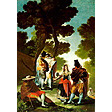 |
|
| Maja and Cloaked Men | 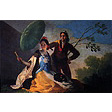 |
|
| Parasol | 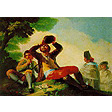 |
|
| Drinker | 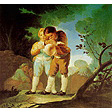 |
|
| Boys Blowing up a Bladder | 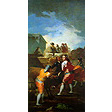 |
|
| Amateur bull-fighting |
 |
InfoGoya 96 is an initiative of the University of Zaragoza, sponsored by the Institution Fernando el Católico of the Deputation of Zaragoza on an Apple Internet Server donated by Apple Computer. |    |